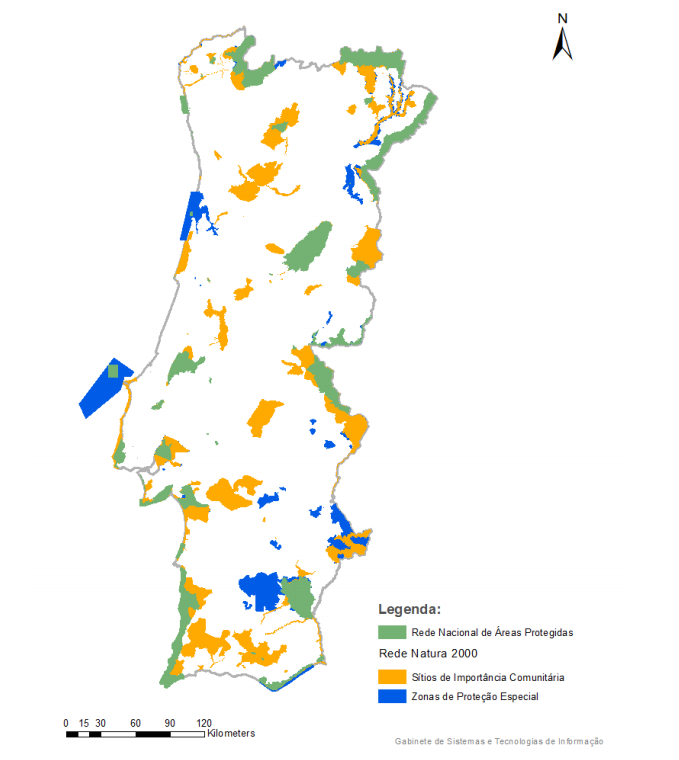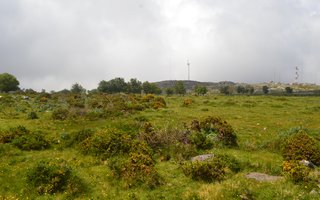A mountainous massif that stands out in the landscape of the county.
Serra d'Arga is the first major obstacle to wet winds from the Atlantic, with a maximum altitude of 825 meters. In this area, the climate is not very severe, although snowfall and periods of frost may occur at the highest points, presenting a temperate climate, typical of the Atlantic Biogeographical Region, with a wetter and colder period and a warmer and drier period in summer months.
This Special Conservation Zone is constituted by a mountainous massif, which is located between the valleys of Lima and Coura, and a flat area, which corresponds to a small river valley - river Âncora. At 800 meters of altitude, there is a plateau with several poorly drained depressions, where there are hygrophilic mosaics associated with wetlands, permanent water courses and temporary flooding areas.
In this SCZ, spontaneous forest is practically non-existent, being very difficult to distinguish it from forest plantations. In the riverside corridor of the Âncora river and in the land surrounding the agricultural land of the mountain villages, some native tree vegetation occurs.
Due to the fires and the few forest replacement actions in the region, exotic species, such as acacias, mimosas and the Hackea sericea shrub, have been proliferating in a significant and worrying way. However, the SCZ brings together conditions for potential regeneration, as well as a set of priority conservation biotopes and species contained in the Habitats Directive.
Recent studies on the region (intermunicipal project “From Serra d'Arga to Foz do Âncora”, NORTE-04-2114-FEDER-000227, 2019), indicate that 88% of the vascular flora taxons found correspond to indigenous plants, having been 32 RELAPE species (Rare, Endemic, Localized and Threatened or in Danger of Extinction) were found. These include the chupadeira-do-Minho (Scrophularia bourgaeana), a very rare Iberian endemism in Portugal, and Laserpitium prutenicum subsp. duriananum which, in Portugal, can only be found in Serra d’Arga.
The Serra de Arga Special Conservation Zone extends over 4493 hectares, of which 2154 hectares (about 48%) are within the boundary of the municipality of Viana do Castelo.
In this SCZ, there are 10 biotopes in Annex I of the Habitats Directive, 2 of which are considered priority: 4020* - Moist Atlantic wetlands of Erica ciliaris and Erica tetralix and 6230* - Herbaceous formations of Nardus, rich in species, in siliceous substrates of the mountain area (and continental Europe's sub-mountain areas)
Serra d'Arga is the first major obstacle to wet winds from the Atlantic, with a maximum altitude of 825 meters. In this area, the climate is not very severe, although snowfall and periods of frost may occur at the highest points, presenting a temperate climate, typical of the Atlantic Biogeographical Region, with a wetter and colder period and a warmer and drier period in summer months.
This Special Conservation Zone is constituted by a mountainous massif, which is located between the valleys of Lima and Coura, and a flat area, which corresponds to a small river valley - river Âncora. At 800 meters of altitude, there is a plateau with several poorly drained depressions, where there are hygrophilic mosaics associated with wetlands, permanent water courses and temporary flooding areas.
In this SCZ, spontaneous forest is practically non-existent, being very difficult to distinguish it from forest plantations. In the riverside corridor of the Âncora river and in the land surrounding the agricultural land of the mountain villages, some native tree vegetation occurs.
Due to the fires and the few forest replacement actions in the region, exotic species, such as acacias, mimosas and the Hackea sericea shrub, have been proliferating in a significant and worrying way. However, the SCZ brings together conditions for potential regeneration, as well as a set of priority conservation biotopes and species contained in the Habitats Directive.
Recent studies on the region (intermunicipal project “From Serra d'Arga to Foz do Âncora”, NORTE-04-2114-FEDER-000227, 2019), indicate that 88% of the vascular flora taxons found correspond to indigenous plants, having been 32 RELAPE species (Rare, Endemic, Localized and Threatened or in Danger of Extinction) were found. These include the chupadeira-do-Minho (Scrophularia bourgaeana), a very rare Iberian endemism in Portugal, and Laserpitium prutenicum subsp. duriananum which, in Portugal, can only be found in Serra d’Arga.
The Serra de Arga Special Conservation Zone extends over 4493 hectares, of which 2154 hectares (about 48%) are within the boundary of the municipality of Viana do Castelo.
In this SCZ, there are 10 biotopes in Annex I of the Habitats Directive, 2 of which are considered priority: 4020* - Moist Atlantic wetlands of Erica ciliaris and Erica tetralix and 6230* - Herbaceous formations of Nardus, rich in species, in siliceous substrates of the mountain area (and continental Europe's sub-mountain areas)
Location
The Serra de Arga SCZ occupies a total area of 4493 hectares, covering the municipalities of Caminha (1891 ha), Ponte de Lima (449 ha) and Viana do Castelo (2154 ha).
Coordinates
Lat: 41.81888607456967
Long: -8.72478059324716
Discover the Natura 2000 Network
Find Points of Interest in the Serra de Arga SCZ
Hello little one!
I'm Piquinhos and I can help you learn more about the Geopark!
Natura 2000 Network
Natura 2000 Network
The Natura 2000 Network is an ecological network for the European Union community space created with the aim of ensuring the conservation of habitats and biodiversity in the Community territory, through the conservation of biotopes and species. It results from the application of the Birds Directive (79/409 / EEC) and Habitats Directive (92/43 / EEC), having been transposed into Portuguese legislation by DL 49/2005, of 24 February. It constitutes an instrument of territorial management in which the guidelines for territorial management are established in the SCZ and SPA, as well as the measures for the conservation of species and habitats.
It is formed by the following classified areas:
- Special Protection Areas (SPA), established under the Birds Directive, aimed at protecting bird species and their habitats;
- Special Conservation Zones (SCZ), established under the Habitats Directive, created by Member States from Sites of Community Importance (SCI), to which the necessary measures are applied to maintain or restore the favorable conservation status of habitats or of species.
In the area covered by the NATURA 2000 Network, human activities must be compatible with the conservation of habitats and species contained in the Annexes of DL 49/2005, of 24 February, with a view to ecologically sustainable management.
The municipality of Viana do Castelo comprises three natural areas of community importance, classified under the Natura 2000 Network, which occupy 15% of the territory: North Coast SCZ , Lima River SCZ and Serra D’Arga SCZ.

Child Mode
Discover the geopark in a simpler format, aimed at the little ones.
Clique ENTER para pesquisar ou ESC para sair
